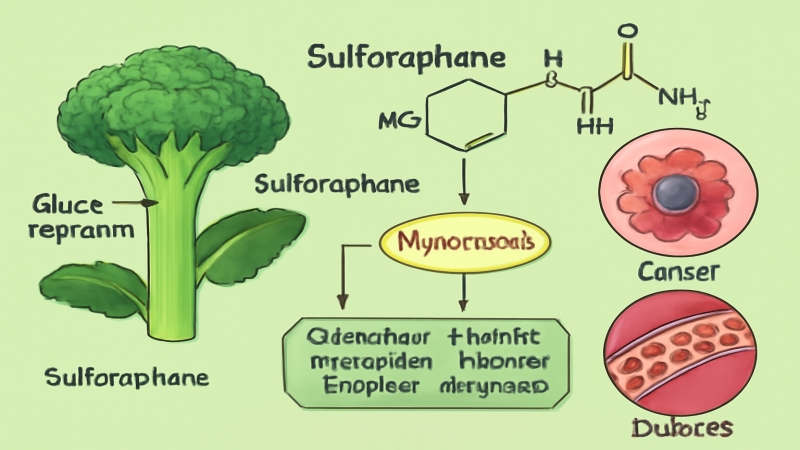El potencial bioquímico y las aplicaciones sostenibles del brócoli como cultivo funcional
El brócoli (Brassica oleracea var. italica L.), un cultivo representativo de la temporada de frío de la familia Brassicaceae, se ha convertido gradualmente en un foco de investigación en alimentos funcionales y economía agrícola debido a su riqueza en compuestos bioactivos y su potencial sostenible. Este artículo presenta los componentes fitoquímicos del brócoli, como los glucosinolatos y el sulforafano, y sus mecanismos moleculares en la prevención de enfermedades metabólicas y el cáncer. También explora las vías de conversión de sus subproductos sin residuos y su importancia revolucionaria para la industria agrícola.
Origen y propagación global
Originario de la región mediterránea, el cultivo global del brócoli se ha expandido a la par que su excelente valor nutricional. Como miembro de la familia Brassicaceae, el brócoli es rico en fibra dietética, vitaminas (como la C y la K) y minerales (como el selenio). Sin embargo, su principal ventaja competitiva reside en sus compuestos bioactivos únicos, en particular los glucosinolatos y su producto hidrolizado, el sulforafano. En los últimos años, la creciente incidencia de síndromes metabólicos (como la diabetes), enfermedades cardiovasculares y cáncer ha impulsado la investigación sobre el potencial preventivo y terapéutico de los productos naturales. Mientras tanto, el aprovechamiento eficiente de los residuos agrícolas se ha convertido en un reto clave para lograr la sostenibilidad. El brócoli se considera un cultivo de oro, con beneficios tanto para la salud como para la economía, gracias a su amplia utilidad, desde sus ramilletes comestibles hasta su aprovechamiento como subproducto.

Mecanismo molecular del eje glucosinolato-sulforafano
El contenido de glucosinolatos en el brócoli varía según la variedad, el entorno de cultivo y los métodos de procesamiento, siendo la glucorafanina el tipo predominante. Cuando la planta sufre daño mecánico o masticación, la enzima endógena mirosinasa hidroliza la glucorafanina en sulforafano. El sulforafano, un tipo de isotiocianato, activa la vía de señalización Nrf2-Keap1-ARE, induciendo la expresión de enzimas de desintoxicación de fase II (p. ej., glutatión-S-transferasa), lo que mejora la defensa antioxidante celular.
Prevención de la diabetes: Estudios en animales demuestran que el sulforafano reduce la inflamación en las células β pancreáticas a través de la vía NF-κB y mejora la resistencia a la insulina (RI). Estudios clínicos indican que la ingesta diaria de 100 μmol de sulforafano puede reducir la glucemia en ayunas entre un 10 % y un 15 % en pacientes con diabetes tipo 2.
Actividad anticancerígena: El sulforafano regula modificaciones epigenéticas, como la inhibición de la actividad de HDAC, para restaurar la expresión de genes supresores de tumores. Induce la detención del ciclo celular (en la fase G2/M) y la apoptosis dependiente de mitocondrias en células de cáncer de mama y de colon.
Protección Cardiovascular: Sus propiedades antiinflamatorias reducen el daño oxidativo al endotelio vascular, inhiben la formación de placa aterosclerótica y regulan el metabolismo lipídico mediante la activación de la vía AMPK.
Fibra dietética y características bajas en calorías
El alto contenido de fibra dietética del brócoli (aproximadamente 2,6 g/100 g de peso fresco) promueve el crecimiento de la microbiota intestinal beneficiosa y regula la producción de ácidos grasos de cadena corta (AGCC), mejorando así la homeostasis metabólica del huésped. Su bajo contenido calórico (aproximadamente 34 kcal/100 g) lo convierte en un componente ideal para dietas para el control de la obesidad.

Desarrollo de productos químicos agrícolas
Los glucosinolatos y polifenoles que quedan en los tallos y hojas del brócoli pueden convertirse en pesticidas o fungicidas naturales mediante técnicas de extracción asistida por ultrasonido. Por ejemplo, los extractos de tallo presentan una inhibición de hasta un 70 % de Botrytis cinerea, sin toxicidad residual, superando significativamente a los pesticidas químicos tradicionales.
Síntesis verde de nanopartículas
Los agentes reductores presentes en los tallos y las hojas (como el ácido ascórbico) pueden facilitar la reducción de iones metálicos (Ag⁺, Fe³⁺) para generar nanopartículas con actividad antimicrobiana o catalítica. Investigaciones demuestran que las nanopartículas de plata (AgNP) sintetizadas a partir de extractos de brócoli tienen una concentración mínima inhibitoria (CMI) de 25 μg/mL contra Escherichia coli. Estas nanopartículas, al aplicarse en películas para envasado de alimentos, pueden prolongar la vida útil de la carne fresca de 3 a 5 días.
Alimentos funcionales y portadores de fármacos
La celulosa y la pectina de los subproductos del brócoli pueden servir como portadores de liberación sostenida para encapsular probióticos o principios activos farmacéuticos. Por ejemplo, las microcápsulas elaboradas con polvo de tallo de brócoli pueden aumentar la tasa de supervivencia de los probióticos en entornos de ácido gástrico en más del 90 %. Además, los precursores de sulforafano presentes en los desechos pueden transformarse mediante ingeniería de fermentación en materias primas de alta pureza para el tratamiento adyuvante del cáncer.
El brócoli no sólo es un cultivo rico en nutrientes, sino también un puente entre la salud humana y la agricultura sostenible.